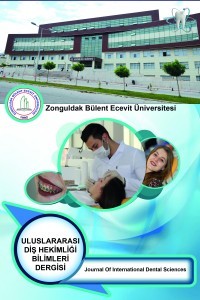ORTODONTİK TEDAVİ SONRASI SÜT KANİN DİŞİNİN ESTETİK REHABİLİTASYONU: OLGU SUNUMU
Anterior dişlerdeki yapı, şekil ve dizilimden kaynaklanan problemler özellikle estetik farkındalığı artan genç bireylerde oldukça önemli hale gelmektedir. Gelişen adeziv teknik ve kompozit rezin materyaller sayesinde bu problemlerin çözümü tek seansta ve doğal diş yapısı korunarak yapılabilmektedir. Ondokuz Mayıs Üniversitesi Diş Hekimliği Fakültesi Ortodonti Anabilim Dalı’ na dişlerinde dizilim sorunu ile başvuran hastanın ortodontik tedavisi tamamlandıktan sonra hasta Restoratif Diş Tedavisi Anabilim Dalı’ na yönlendirilmiştir. Kliniğimizde direkt kompozit rezinler kullanılarak hastanın mevcut 63 numaralı üst süt kanin dişine daimî kanin diş formu verilmiş ve var olan estetik problem giderilmiştir.
Anahtar Kelimeler:
KOMPOZİT RESTORASYON, ESTETİK, DİREKT KOMPOZİT LAMİNATE VENEER, RESTORATİF DİŞ TEDAVİSİ
ESTHETİC REHABILITATION OF PRİMARY CANINE TEETH AFTER ORTHODONTIC TREATMENT: A CASE REPORT
Problems arising from the structure, shape and arrangement of anterior teeth become very important especially in young individuals with increased aesthetic awareness. Thanks to the developing adhesive technique and composite resin materials, these problems can be solved in a single session while preserving the natural tooth structure. The patient, who applied to Ondokuz Mayıs University Faculty of Dentistry, Department of Orthodontics with a misalignment of his teeth, was referred to the Department of Restorative Dentistry after orthodontic treatment was completed. In our clinic, a permanent canine tooth form was given to the patient's 63 upper primary canine tooth by using direct composite resins and the aesthetic problem was resolved.
Keywords:
Composite restoration, direct composite laminate veneer, restorative dentistry, aesthetics,
___
- 1. Peumans M, Van Meerbeek B, Lambrechts P, Vanherle G. The 5-year clinical performance of direct composite additions to correct tooth form and position. I. Esthetic qualities. Clin Oral Investig. 1997;1(1):12-8.
- 2. Chu FC, Siu AS, Newsome PR, Wei SH. Management of median diastema. Gen Dent. 2001;49(3):282-7; quiz 8-9.
- 3. Oesterle LJ, Shellhart WC. Maxillary midline diastemas: a look at the causes. J Am Dent Assoc. 1999;130(1):85-94.
- 4. Aktan AM, Kara I, Sener I, Bereket C, Celik S, Kirtay M, et al. An evaluation of factors associated with persistent primary teeth. Eur J Orthod. 2012;34(2):208-12.
- 5. Robinson S, Chan MF. New teeth from old: treatment options for retained primary teeth. Br Dent J. 2009;207(7):315-20.
- 6. Joshi MR. Transmigrant mandibular canines: a record of 28 cases and a retrospective review of the literature. Angle Orthod. 2001;71(1):12-22.
- 7. Shapira Y, Kuftinec MM. Intrabony migration of impacted teeth. Angle Orthod. 2003;73(6):738-43; discussion 44.
- 8. Sletten DW, Smith BM, Southard KA, Casko JS, Southard TE. Retained deciduous mandibular molars in adults: a radiographic study of long-term changes. Am J Orthod Dentofacial Orthop. 2003;124(6):625-30.
- 9. Rune B, Sarnäs KV. Root resorption and submergence in retained deciduous second molars. A mixed-longitudinal study of 77 children with developmental absence of second premolars. Eur J Orthod. 1984;6(2):123-31.
- 10. Gribble AR. Multiple diastema management: an interdisciplinary approach. J Esthet Dent. 1994;6(3):97-102.
- 11. Wolff D, Kraus T, Schach C, Pritsch M, Mente J, Staehle HJ, et al. Recontouring teeth and closing diastemas with direct composite buildups: a clinical evaluation of survival and quality parameters. J Dent. 2010;38(12):1001-9.
- 12. Venturini D, Cenci MS, Demarco FF, Camacho GB, Powers JM. Effect of polishing techniques and time on surface roughness, hardness and microleakage of resin composite restorations. Oper Dent. 2006;31(1):11-7.
- ISSN: 2149-8628
- Yayın Aralığı: Yılda 3 Sayı
- Yayıncı: Zonguldak Bülent Ecevit Üniversitesi
Sayıdaki Diğer Makaleler
ÖN ISITMA İŞLEMİNİN CAM İYONOMER SİMANIN SERTLEŞME SÜRESİNE ETKİSİ
Ebru HAZAR BODRUMLU, Gözde ARSLAN
İskeletsel Sınıf III Maloklüzyonun Yüz Maskesi ve Asimetrik Diş Çekimi ile Tedavisi: Vaka Raporu
İrem YOLCU, Büşra DEMİR ÇİÇEK, Orhan ÇİÇEK
ORTODONTİK TEDAVİ SONRASI SÜT KANİN DİŞİNİN ESTETİK REHABİLİTASYONU: OLGU SUNUMU
Fikret YILMAZ, Ayşenur ÇAKIR, Nursel ARICI
Emre BODRUMLU, Şerife Büşra ARSLAN
Gediz GEDUK, Emre HAYLAZ, Çiğdem ŞEKER
